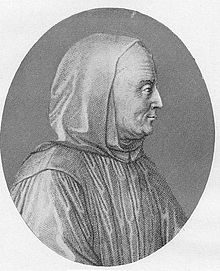- Jean Mabillon
-
Jean Mabillon (23 November 1632 – 27 December 1707) was a French Benedictine monk and scholar, considered the founder of palaeography and diplomatics.[1]
He was born in Saint-Pierremont, Ardennes as the son of Estienne Mabillon (who died in 1692 at age 104) and Jeanne Guérin. At age 12 he entered the Collège des Bons Enfants in Reims and in 1650 entered the seminary. He left the seminary in 1653 and instead became a monk in the Maurist Abbey of Saint-Remi. His devotion to his studies there left him ill, and he was sent to Corbie in 1658 to regain his strength. In 1663 he transferred again, to Saint-Denis Abbey near Paris, and the next year to the Abbey of Saint-Germain-des-Prés in Paris, where he met and worked with many other scholars, including Luc d'Achery, Charles du Fresne, Sieur du Cange, Etienne Baluze, and Louis-Sébastien Le Nain de Tillemont.
In Saint-Germain, Mabillon edited the works of Saint Bernard of Clairvaux (published in 1667), and also worked on the Lives of the Benedictine Saints ("Acta Ordinis S. Benedicti") (published in nine volumes between 1668 and 1701). The later work was undertaken in collaboration with Luc d'Achery, an older scholar and long-lasting librarian of Saint-Germain-des-Prés, who had collected the historical materials which Mabillon used. A foreword which Mabillon later added used the lives of the saints in order to illustrate the history of the early Middle Ages.
In 1681 Mabillon published his De re diplomatica, which investigated different types of medieval documents and manuscripts, including scrutiny of their script, style, seals, signatures, testimonia, and other intrinsic and extrinsic factors, using an acquired taste derived from long experience, and consulting the views of other document scholars. Manuscripts from many archives are addressed, and references made to items dating back to Dagobert I (King of the Franks, c.629-639). Concerned often with "distinguishing genuine documents from forgeries" the work is now seen as the foundation work of palaeography and diplomatics. Mabillon writes:
"I do not deny that in fact some documents are false and others interpolated, but all of them should not be dismissed for that reason. Rather, it is necessary to devise and hand down rules for distinguishing genuine manuscripts from those that are false and interpolated. ... I undertook this task after long familiarity and daily experience with these documents. For almost twenty years I had devoted my studies and energies to reading and examining ancient manuscripts and archives, and the published collections of ancient documents. ... I compared and weighed them with one another that I might be able to compile a body of knowledge which was not merely scanty and meager, but as accurate and as well-tested as possible in a field which had not been previously investigated."[2]
This work brought him to the attention of Jean-Baptiste Colbert, who offered him a pension (which he declined), and King Louis XIV. He began to travel throughout Europe, to Flanders, Switzerland, Germany, and Italy, in search of medieval manuscripts and books for the royal library.
However, there were opponents to his work. Some of the less scholarly monks in his own abbey criticized his Lives for being too academic, and de Rancé, abbot of La Trappe, declared that he was breaking the rules of his order by devoting his life to study rather than manual labour.[3] He also caused trouble by denouncing the veneration of the relics of "unknown saints," wrote a controversial critique of the works of Saint Augustine, and was accused of Jansenism, but at all times he was supported by the king and the church.
In 1701 Mabillon was appointed by the king as one of the founding members of the Académie des Inscriptions et Belles-Lettres, and in 1704 a supplement to De re diplomatica was published. In 1707 he died and was buried in the church of Saint-Germain-des-Prés, in Paris.
According to a modern historian and critic, Mabillon was the "greatest historical scholar of his century."[4]
The Mabillon station of the Paris Métro is named after him.
References
- ^
 "Jean Mabillon". Catholic Encyclopedia. New York: Robert Appleton Company. 1913.
"Jean Mabillon". Catholic Encyclopedia. New York: Robert Appleton Company. 1913. - ^ Jean Mabillon, De re diplomatica (1681), his Supplement to it of 1704, translated from Latin by Richard Wertis (using Naples edition of 1789) as On Diplomatics, in Peter Gay and Victor G. Wexler, editors, Historians at Work, Volume Two, Villa to Gibbon (New York: Harper & Row 1972): blockquote at 165, prior short quote at 167, document scrutiny at 168 & 169, Dagobert at 192. Three long excerpts from the Supplement appear at 164-198, introduced followed by a short bibliography at 161-163.
- ^ Mette B. Bruun, "A Case in which a Revitalization of Something Medieval Turned out not to be Medievalism," in: Falling into Medievalism, ed. Anne Lair and Richard Utz. Special Issue of UNIversitas: The University of Northern Iowa Journal of Research, Scholarship, and Creative Activity, 2.1 (2006).
- ^ Fritz Stern, editor, The Varieties of History (Cleveland: Meridian Books 1956) at 406.
External links
 "Jean Mabillon". Catholic Encyclopedia. New York: Robert Appleton Company. 1913.
"Jean Mabillon". Catholic Encyclopedia. New York: Robert Appleton Company. 1913.- Jean Mabillon: De re diplomatica (1709) - Digital Reproduction (website in German)
Categories:- 1632 births
- 1707 deaths
- 17th-century Latin-language writers
- 18th-century Latin-language writers
- Benedictines
- Burials at the Abbey of Saint-Germain-des-Prés
- French Christian monks
- French theologians
- French medievalists
- Palaeography
- People from Ardennes
- Corbie Abbey
- Members of the Académie des Inscriptions et Belles-Lettres
- ^
Wikimedia Foundation. 2010.

